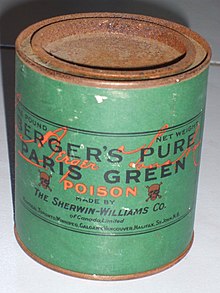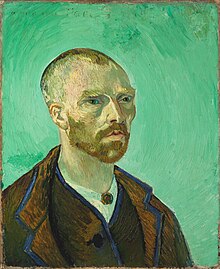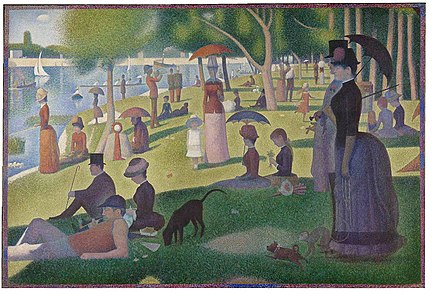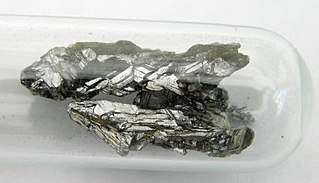
Arsenic is a chemical element; it has symbol As and atomic number 33. Arsenic occurs in many minerals, usually in combination with sulfur and metals, but also as a pure elemental crystal. Arsenic is a notoriously toxic metalloid. It has various allotropes, but only the grey form, which has a metallic appearance, is important to industry.

A pigment is a powder used to add color or change visual appearance. Pigments are completely or nearly insoluble and chemically unreactive in water or another medium; in contrast, dyes are colored substances which are soluble or go into solution at some stage in their use. Dyes are often organic compounds whereas pigments are often inorganic. Pigments of prehistoric and historic value include ochre, charcoal, and lapis lazuli.

Arsine (IUPAC name: arsane) is an inorganic compound with the formula AsH3. This flammable, pyrophoric, and highly toxic pnictogen hydride gas is one of the simplest compounds of arsenic. Despite its lethality, it finds some applications in the semiconductor industry and for the synthesis of organoarsenic compounds. The term arsine is commonly used to describe a class of organoarsenic compounds of the formula AsH3−xRx, where R = aryl or alkyl. For example, As(C6H5)3, called triphenylarsine, is referred to as "an arsine".

Basic copper carbonate is a chemical compound, more properly called copper(II) carbonate hydroxide. It is an ionic compound consisting of the ions copper(II) Cu2+
, carbonate CO2−
3, and hydroxide OH−
.
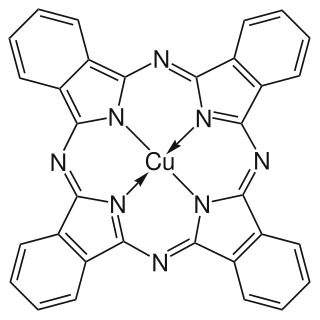
Copper phthalocyanine (CuPc), also called phthalocyanine blue, phthalo blue and many other names, is a bright, crystalline, synthetic blue pigment from the group of dyes based on phthalocyanines. Its brilliant blue is frequently used in paints and dyes. It is highly valued for its superior properties such as light fastness, tinting strength, covering power and resistance to the effects of alkalis and acids. It has the appearance of a blue powder, insoluble in most solvents including water.

Orpiment, also known as ″yellow arsenic blende″ is a deep-colored, orange-yellow arsenic sulfide mineral with formula As
2S
3. It is found in volcanic fumaroles, low-temperature hydrothermal veins, and hot springs and may be formed through sublimation.

Verdigris is a common name for any of a variety of somewhat poisonous copper salts of acetic acid, which range in colour from green to a bluish-green depending on their chemical composition. Once used as a medicine and pharmaceutical preparation, Verdigris occurs naturally, creating a patina on copper, bronze, and brass, and is the main component of a historic green pigment used for artistic purposes from antiquity until the late 20th century, including in easel painting, polychromatic sculptures, and illumination of maps. However, due to its instability, its popularity declined as other green pigments became readily available. The instability of its appearance stems from its hydration level and basicity, which changes as the pigment interacts with other materials over time.
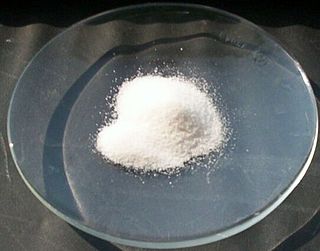
Arsenic trioxide is an inorganic compound with the formula As
2O
3. As an industrial chemical, its major uses include the manufacture of wood preservatives, pesticides, and glass. It is sold under the brand name Trisenox among others when used as a medication to treat a type of cancer known as acute promyelocytic leukemia. For this use it is given by injection into a vein.

Copper(II) hydroxide is the hydroxide of copper with the chemical formula of Cu(OH)2. It is a pale greenish blue or bluish green solid. Some forms of copper(II) hydroxide are sold as "stabilized" copper(II) hydroxide, although they likely consist of a mixture of copper(II) carbonate and hydroxide. Cupric hydroxide is a strong base, although its low solubility in water makes this hard to observe directly.

Copper arsenate (Cu3(AsO4)2·4H2O, or Cu5H2(AsO4)4·2H2O), also called copper orthoarsenate, tricopper arsenate, cupric arsenate, or tricopper orthoarsenate, is a blue or bluish-green powder insoluble in water and alcohol and soluble in aqueous ammonium and dilute acids. Its CAS number is 7778-41-8 or 10103-61-4.

Scheele's Green, also called Schloss Green, is chemically a cupric hydrogen arsenite, CuHAsO
3. It is chemically related to Paris Green. Scheele's Green was invented in 1775 by Carl Wilhelm Scheele. By the end of the 19th century, it had virtually replaced the older green pigments based on copper carbonate. It is a yellowish-green pigment commonly used during the early to mid-19th century in paints as well as being directly incorporated into a variety of products as a colorant. It began to fall out of favor after the 1860s because of its toxicity and the instability of its color in the presence of sulfides and various chemical pollutants. The acutely toxic nature of Scheele's green as well as other arsenic-containing green pigments such as Paris Green may have contributed to the sharp decline in the popularity of the color green in late Victorian society. By the dawn of the 20th century, Scheele's green had completely fallen out of use as a pigment but was still in use as an insecticide into the 1930s. At least two modern reproductions of Scheele's green hue with modern non-toxic pigments have been made, with similar but non-identical color coordinates: one with hex#3c7a18 and another with hex#478800. The latter is the more typically reported color coordinate for Scheele's green.
Chromated copper arsenate (CCA) is a wood preservative containing compounds of chromium, copper, and arsenic, in various proportions. It is used to impregnate timber and other wood products, especially those intended for outdoor use, in order to protect them from attack by microbes and insects. Like other copper-based wood preservatives, it imparts a greenish tint to treated timber.
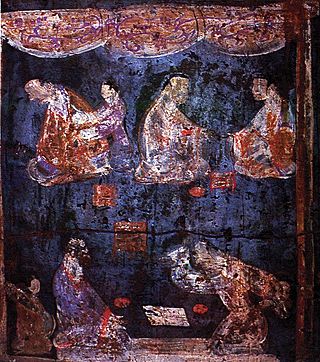
Han purple and Han blue are synthetic barium copper silicate pigments developed in China and used in ancient and imperial China from the Western Zhou period until the end of the Han dynasty.
Trimethylarsine (abbreviated TMA or TMAs) is the chemical compound with the formula (CH3)3As, commonly abbreviated AsMe3 or TMAs. This organic derivative of arsine has been used as a source of arsenic in microelectronics industry, a building block to other organoarsenic compounds, and serves as a ligand in coordination chemistry. It has distinct "garlic"-like smell. Trimethylarsine had been discovered as early as 1854.
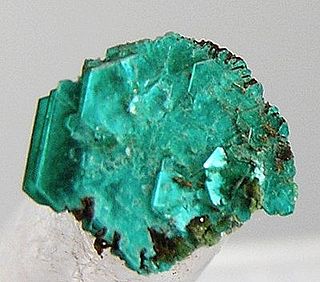
Chalcophyllite is a rare secondary copper arsenate mineral occurring in the oxidized zones of some arsenic-bearing copper deposits. It was first described from material collected in Germany. At one time chalcophyllite from Wheal Tamar in Cornwall, England, was called tamarite, but this name is now discredited. At Wheal Gorland a specimen exhibiting partial replacement of liriconite, Cu
2Al(AsO
4)(OH)
4·(4H
2O), by chalcophyllite has been found. The mineral is named from the Greek, chalco "copper" and fyllon, "leaf", in allusion to its composition and platy structure. It is a classic Cornish mineral that can be confused with tabular spangolite.
This is an index of articles relating to pesticides.
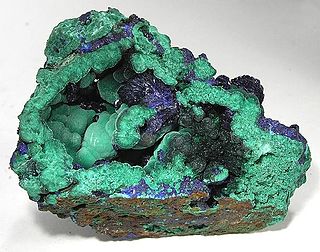
Green pigments are the materials used to create the green colors seen in painting and the other arts. Most come from minerals, particularly those containing compounds of copper. Green pigments reflect the green portions of the spectrum of visible light, and absorb the others. Important green pigments in art history include Malachite and Verdigris, found in tomb paintings in Ancient Egypt, and the Green earth pigments popular in the Middle Ages. More recent greens, such as Cobalt Green, are largely synthetic, made in laboratories and factories.

Compounds of arsenic resemble in some respects those of phosphorus which occupies the same group (column) of the periodic table. The most common oxidation states for arsenic are: −3 in the arsenides, which are alloy-like intermetallic compounds, +3 in the arsenites, and +5 in the arsenates and most organoarsenic compounds. Arsenic also bonds readily to itself as seen in the square As3−
4 ions in the mineral skutterudite. In the +3 oxidation state, arsenic is typically pyramidal owing to the influence of the lone pair of electrons.
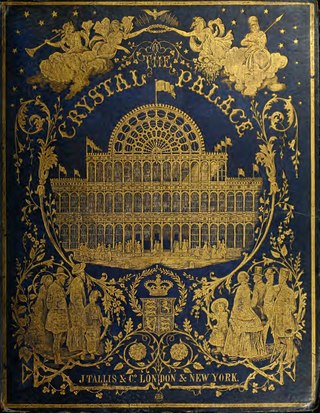
The Poison Book Project is a project of the Winterthur Museum, Garden and Library and the University of Delaware to identify and catalog books known to contain poisonous substances, particularly arsenic in Paris green pigments. It was started in 2019 when Winterthur staff members Melissa Tedone and Rosie Grayburn identified a book containing Paris green in the institution's collection. The project has since confirmed at least 100 other books from libraries across the world that contain Paris green, allowing librarians to take measures to minimize the risk to those handling the books.



![A subunit of the Cu2As3O6(OAc) framework, highlighting the [As3O6] ligand. Color code: Cu = blue, As = large gray, C = gray, O = red. Subunit of Cu2As3O3(OAc) (ASOCUA).png](http://upload.wikimedia.org/wikipedia/commons/thumb/7/78/Subunit_of_Cu2As3O3%28OAc%29_%28ASOCUA%29.png/220px-Subunit_of_Cu2As3O3%28OAc%29_%28ASOCUA%29.png)
